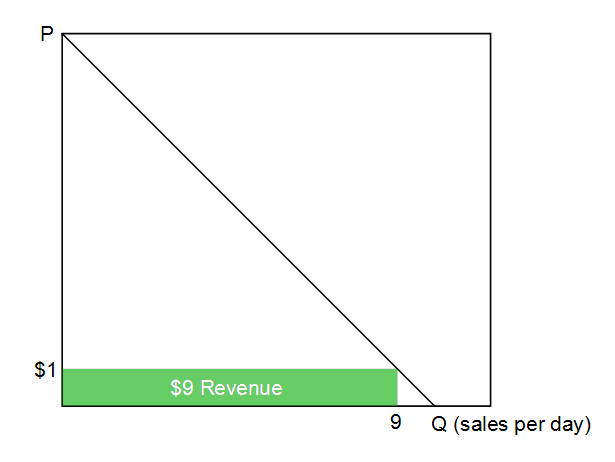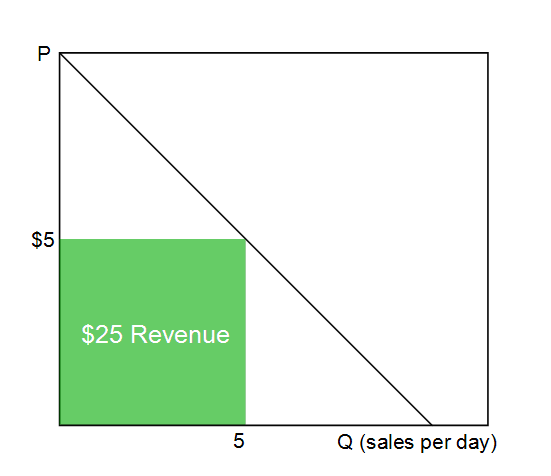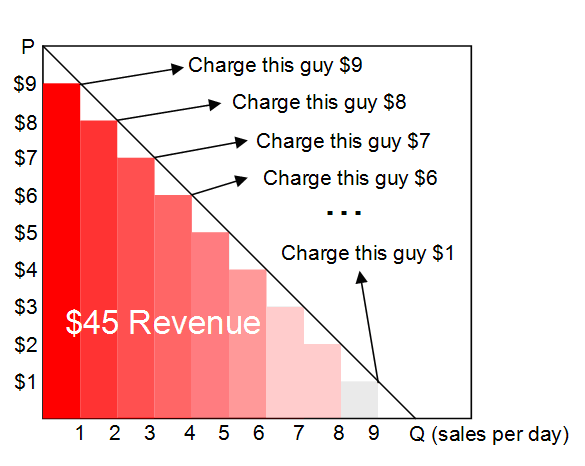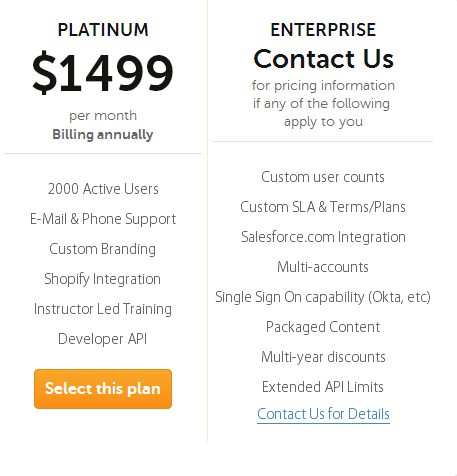Setting the price for your product is a tough decision, and it's one that can make or break your business. This article will explain the basics of product pricing and show you how you can drastically increase your revenue by selling your product at multiple prices.
Whenever you set a price, you must trade off price with quantity. Suppose you're trying to price the mobile app "Happy Birds" that you just created. The great thing about software is that is costs nothing to make another copy. In economics, we say that the marginal (or additional) cost is zero. This means that maximizing profit is the same as maximizing revenue.
If you try to sell "Happy Birds" for $9 you're going to have some problems. In a world of 99 cent apps, your app is priced like a Lamborghini. You'll make a lot of money per sale, but not many people will plunk down that kind of cash for an unknown copy-cat game.

At a low price of $1, you'll sell quite a few more copies, but won't make much per sale.

Somewhere in between is the optimal price that will bring in the most revenue.

Through trial and error, you'll learn about demand for your product and be able to find this price. For, "Happy Birds" this works out to a price of $5 which corresponds to $25 of revenue every day. A big improvement over $9 per day!
The problem is, you're still leaving a lot of money on the table. You have "Happy Birds" fanatics who wouldn't have flinched at paying more for the game. And there are broke high school kids, who could afford to pay something, just not $5. This is money that you are leaving on the table!
You could capture this money if you were able to charge everyone exactly what they are willing to pay. For "Happy Birds," doing so would increase your revenue from $25 to $45!

Charging different prices to different people for the same product is known in economics as price discrimination. Price discrimination decouples price and quantity and allows companies to have their cake and eat it too when they set prices.
The problem is, people won't tell you how much they're willing to pay and, as of yet, there is no way to read someone's mind. Instead, here are some strategies to differentiate between price sensitive and price insensitive consumers.
1. Segment Customers by Observable Characteristics
Certain groups of people tend to be more price sensitive than others. For example, seniors and students tend to have less income than working-age people and are, as a group, more frugal. Therefore, these customers are frequently offered discounts at movie theatres, museums, and ski resorts. Similarly, almost all tech companies from Apple to Amazon offer academic discounts.

A customer's price sensitivity may also differ by location. For example, Florida residents are charged a lower price than tourists for entry to Disney World. This isn't altruism on the part of Disney World. As a group, tourists traveling from around the world will be richer and less price sensitive. Similarly, textbook publishers know that students in places like India can't afford to spend $200 for a textbook. So, they release international editions with identical content at a fraction of U.S. prices.
Businesses are one of the least price sensitive groups. In contrast, non-profit organizations are often on a tight budget. Therefore, it is extremely common for companies to offer special non-profit pricing. Not only is this good public relations, it is profit-maximizing behavior!

2. Let Customers Segment Themselves by Jumping Through Hoops
You can't judge a book by it's cover and you can't always identify a price sensitive customer by the way they look. An alternative approach is allowing price sensitive customers to reveal their preferences. Price sensitive consumers tend to place a lower value on their time. Therefore, offering customers a discount in exchange for inconveniencing themselves will make cheaper customers reveal themselves.
Traditional coupons are a good example of this. Historically, clipping coupons required searching though a newspaper with a pair of scissors. Only the most frugal consumers would go through the hassle. Today, searching Google for promo codes is easier, but still requires checking code after code until you find one that is not expired.

Long lines and wait times are often used to segment customers. The guy camping outside of Best Buy on Black Friday to buy a TV probably wouldn't have paid full price anyway. Download sites frequently use this tactic. Free users must wait 30 seconds to download, paid users can download immediately.
Time-specific sales can also be used to filter frugal shoppers from the rest of the pack. The most price sensitive will wait for sales. The rest won't bother. JC Penney recently tried to get rid of it's sales and pursue a strategy of simple, everyday prices. The experiment was a disaster and sales plummeted. Everyday prices were too high for bargain hunters and margins were too low to sufficiently profit off of price-insensitive customers. In contrast, online membership shopping sites like Gilt, which hosts 36-48 hour sales, have been wildly successful.

3. Wait Until Customers Approach you to Segment Them
If you don't post prices, or are in an industry known for haggling, you'll have the ability to set the price for the individual customer based on their observable characteristics. As a tourist in China, I'll pay more for trinkets at the local market than a local would. Similarly, the guy walking into the car dealership in an Armani suit is more likely to pay sticker price.
In the online world, "Contact Us for Pricing," is a frequently a euphemism for "we'll tell you how much it will cost after we learn how much money you have". Tread carefully with this type of price discrimination as you can open yourself up to reputational and legal risk. Amazon faced a public uproar when it was accused of selling the same DVD at different prices to different customers.
4. Segment Customers based on their Purchasing Behavior.
Sometimes, the manner in which your customers buy your product will tell you something about their willingness to pay. For example, airlines typically charge a lower price for tickets that include a Saturday stay over. This is because traveling over the weekend is typically done by leisure travelers who are more sensitive to price changes. In the same vein, flights purchased at the last minute are typically for urgent travel (closing a business deal, a sickness in the family etc.) and are priced at a premium.
Similarly, customers buying in bulk will frequently be more price sensitive. They're spending a lot of money and they know they have options. Here is the volume discount table for a software company from Australia.

Does the 100th license cost the software company any more or less to produce than the 1st license? No! Volume discounts are just an effective means of price discrimination.
5. Use Product Features to Encourage Customers to Segment Themselves
Frequently, customers willing to pay the most for your product are interested in a unique set of features. If you charge more for products with these features, you can effectively price discriminate. For example, Litmos.com sells an online training platform as a service. Its two most expensive pricing plans look like this:

Custom service level agreements and Salesforce.com Integration aren't more expensive because they cost more to produce. They are more expensive because they signal that the customer is flush with cash. Patrick McKenzie has touted this idea repeatedly on his must-read blog, and uses a similar approach to sell his appointment reminder software. He uses HIPAA (Health Insurance Privacy) compliance as a proxy for a company's ability to pay.
Kickstarter does something very similar by using a multi-tiered reward model. For example, check out the recent wildly successful Veronica Mars movie campaign. It contained 32 different pledge levels! You could spend $1 and get updates about the project or spend $10,000 to get a speaking role in the movie. For $400, you could get Rob Thomas to follow you on Twitter. The project was targeting people all across the demand curve. Pledge levels weren't set based on the cost of the reward (e.g. it doesn't cost them anything to follow someone on Twitter). The pledge levels were based on the perceived value to the fans.
If your product is SAAS, you'll want to isolate which features are a good proxy for customers' willingness and ability to pay. Here at ContactMetrics, our plans (planned) differ based on the number of sites tracked and the number of responses that are received. The former allows us to identify agencies that have multiple clients and the latter allows us to identify prominent web sites with only 1 domain, but many visitors. Since both of these customer groups will receive a disproportionate amount of value from our product, it is both fair and efficient that they should contribute more to it's development.
Before you go crazy segmenting your customers and engaging in price discrimination, consider a few caveats.
Caveats
Price discrimination works best when:
1. Goods can't be resold
Price discrimination won't work if your customers can resell the good to the other groups. That makes it ideal for services or non-tangible products. You'll notice that movie theaters tend to offer generous student discounts, but liquor stores don't.
2. Profit margins are high and marginal costs are low
If a grocery store only has an average markup of 3%, there is not a lot of room for price discrimination. Fortunately, if you're selling software or information online, you're a prime candidate to price discriminate.
Parting Words of Caution
By segmenting your customers, you'll make your product available to people who couldn't have afforded it previously. But, you'll also be extracting more value from your happiest customers. There is nothing wrong with that, especially if you're providing a lot of value. But, be careful. Don't undervalue the goodwill of your customers!

